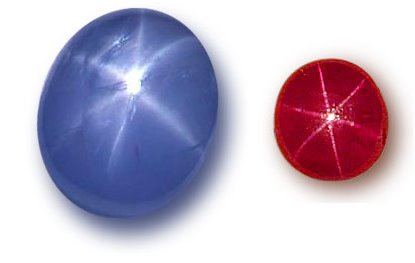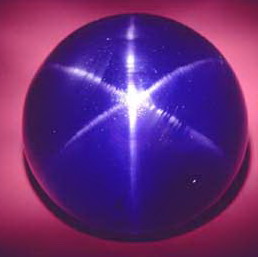- Star Resulting From Selective Absorption
- Star Phenomena From Interference Light
- Distinguishing Star Gemstones

Of special interest in the study of gemology is the subject of phenomena. Briefly, as applied here, it is described as those unusual optical effects displayed by some gem varieties. The interesting crossed lines of reflected light seen in star sapphires and star rubies, the billowy bluish sheen displayed by moonstone, and the vivid multiple flashes of color observed in fine opals are all examples of phenomena. These and other unusual effects will be studied in this assignment.
The phenomenal effects observed in gems may be classified under one of three main types:
- Reflection of light from inclusions,
- Selective absorption of light, and
- Interference of light.
Star Phenomena Resulting From Reflection of Light
Chatoyancy (pronounced shah-TOY-an-see)

Chatoyancy is the property of a gemstone to reflect light in a line resembling the contracted pupil of a cat's eye. In a fine cat's-eye it appears as a narrow, well-defined light-colored streak across the summit of the stone that moves as the stone is turned. Cat's-eye is a variety of the gem species chrysoberyl. When chrysoberyl exhibits a movable light that is not confined to a narrow band, it is usually called CYMOPHANE (pronounced CY-mo-fane), although the term is sometimes applied to chrysoberyl that exhibits a movable light effect of any kind.
Fine cat's-eye contains a vast number of minute, parallel needlelike inclusions that may be cavities or, more often, included fibrous crystals. The light-colored streak, which is always at right angles to the fibers, is produced by reflections from these inclusions (Figure 1). A high or medium-high cabochon results in the most desirable "eye," since this form of cutting limits the reflections that are visible from anyone direction to a sharp band of light. In a flat-topped stone, reflections are seen from the entire surface (sheer). In a cabochon cut, the light reflected from the Inclusions is refracted out at different angles; thus only a narrow band of light is seen from anyone direction (Figure 2).
A form of chatoyancy may be observed by holding a spool of glossy thread under a single light source. A narrow chatoyant band will be visible on the apex of the spool at right angles to the threads. The round form of the spool, serves the same function as the cabochon cut of a chatoyant gem.
Tiger's-eye, a variety of quartz often incorrectly called "crocidolite", is usually a yellow-brown stone with a wavy fibrous structure. The appearance is similar to a series of broad cat's-eye effects. It may be dyed any number of colors. Tiger's-eye was formed when crocidolite, or blue asbestos, a fibrous mineral, was replaced by quartz but whose fibrous structure was preserved. In other words, the quartz is a pseudomorph after crocidolite. When cut in cabochon, a cat's-eye effect is produced by reflection from these fibers. The blue variety, which probably contains unaltered crocidolite, is sometimes called hawk's-eye. There is also a fine cat's-eye variety of quartz that resembles its more valuable counterpart, chrysoberyl cat's-eye. This type has much finer inclusions than tiger's-eye, but lacks the silky transparency of chrysoberyl. There are a number of other gemstones in which cat's-eye varieties are more or less uncommon. These include tourmaline, beryl, feldspar and a few infrequently encountered gemstones such as scapolite, diopside and enstatite.
Judgment of quality of a cat's-eye is based on color, the position of the eye (it should be straight and thin and follow the crest of the cabochon exactly when the light source is directly over the stone), transparency, and the shape of the stone. The stone should not be heavy below the girdle; it should have a sufficiently sharp girdle to permit the prongs to hold it firmly; it should have a symmetrical outline; and its cabochon surface should not be too high nor too sharply domed. The eye should follow the long diameter of the stone.
Asterism
Stones cut in cabochon that reflect light in the form of intersecting bands of light are known as ASTERIAS. The words ASTERIA, ASTERIATED AND ASTERISM are derived from the Greek word ASTER, meaning STAR. The star may be four, six or even twelve rayed. Three, five and ten-rayed stars are also known, but these are "freak" gems in which one ray of the star is missing due to the absence of essential inclusions in one area of the stone. Although stars are most commonly seen in ruby and sapphire, other gems that occasionally display asterism are almandite garnet, spinel, beryl, rose quartz and chrysoberyl.
In general, asterism is caused by reflection of light from minute, oriented needlelike crystals. When the stone is cut en cabochon, the reflected light is visible as bright intersecting lines. In star stones of the corundum species, which crystallize in the hexagonal system, numerous tiny elongated crystals are distributed in planes perpendicular to the principal vertical crystal axis and oriented in directions parallel to the faces of the hexagonal (six-sided) prism (Figure 3). The star-producing inclusions in synthetic star ruby and sapphire are arranged in the same pattern as in the natural.
It will be noted in Figure 3 that these minute crystals are oriented in three directions and intersect at 60°, through reflection, they produce three chatoyant bands at right angles to the inclusions, thus forming a six-rayed star. When observing a cross section of a crystal of this nature, one can see a surface sheen, which is the result of light being reflected from these oriented crystals within the stone. It is partly on this basis that one can determine whether a crystal can be fashioned into a star stone. This surface sheen can be resolved into a star by the use of the cabochon cut. The girdle must be placed exactly parallel to the plane in which the needles lie, in order for the star to be centered at the apex of the cabochon.
The minute needlelike inclusions that are essential to fine stars are called SILK, because of the silky sheen they impart to the stone. Needles coarse enough to be visible individually under 10x or 30x are too large for sharp star production. Just as the large fibers in most specimens of tiger's-eye produce only a wide chatoyant band, coarse needles in any other gem mineral refection of the star in first-grade Linde synthetic star sapphires and rubies is the result of the even distribution and tiny size of the needles, or silk. Since synthetic stars contain needlelike inclusions that are only clearly visible under 100x or higher magnification, the presence of coarse needles may still be considered proof of genuine origin in corundum.
Aventurescence (pronounced ah-ven-chur-ESS-ence).
Aventurescence is the name applied to display of bright or strongly colored reflections from a translucent mineral. It is seen in sunstone ( a variety of oligoclase feldspar) and in aventurine quartz (a spangled green variety of massive quartz).
In feldspar it is caused by reddish, metallic reflections from minute, flaky inclusions of a variety of hematite arranged parallel to planes of repeated twinning. Fine sunstone resembles moonstone, but with a golden instead of a bluish reflection. In quartz it consists of fairly vivid reflections from green inclusions in a white background, or shiny reflections from included flakes of mica in a green background.

